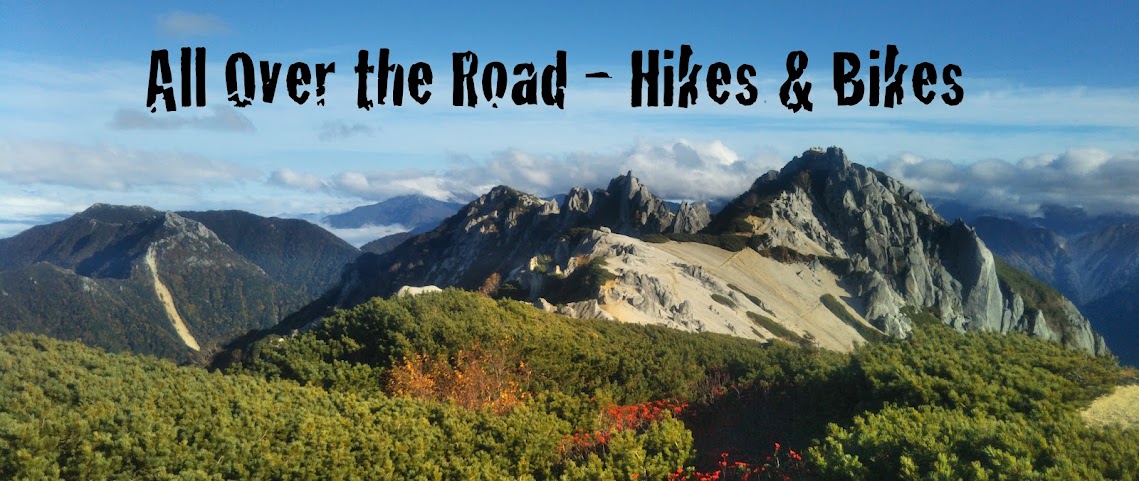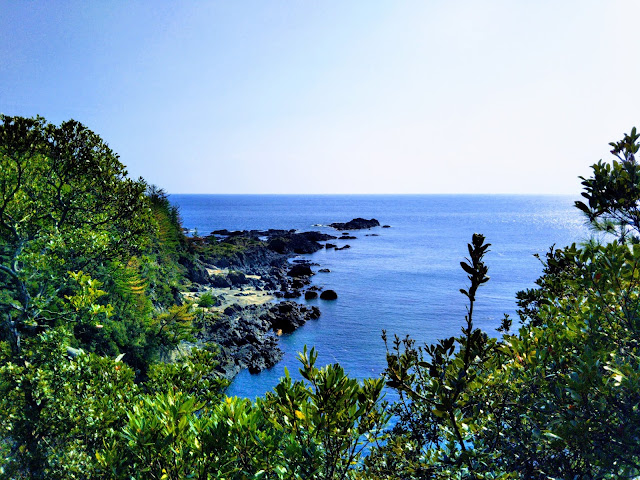Boasting fairytale waterfalls, relentless rain forests, and giant cedars older than Jesus, the Japanese island of Yakushima is a dense display of natural mystique. Spring each year sees the return of sea turtles to Inakahama Beach, where the females lay their eggs in the same spot they themselves hatched 25 or 30 years prior. Wild monkeys sit in the road along the western Seibu-Rindo, staring down motorists, daring them to hit them while the deer quickly turn tail and disappear into the woods.
And then there's the rain - as much as 8 meters annually in some places. This soil-soaking climate contributes not only to the hardiness of those multi-millenial cedars but to moss-covered forestscapes so captivating you're bound to fill up your memory card.
I'd wanted to see Yakushima since the moment I knew it existed. I was so intrigued with the whole rain-soaked package that by 2004 I was ready to cycle the 400 miles from Osaka through Shikoku to Kagoshima where I would pedal right onto the Yakushima ferry and cycle and hike the hell out of the place - and then cycle home, all in the space of my upcoming two-week winter break.
Instead, in a strange and sudden change of heart, I put on a suit
and tie, bought a box of tangerines, and hopped a train north to Fukushima to ask
a peach farmer for his permission to marry his daughter.
A potentially ruinous turn of events, but thirteen years and three kids later I finally found myself on my way to Yakushima, as a guide on a two-week cycling tour that would end with a one-day, 100-kilometer circuit of this mystical, monkey-ridden island. No matter I'd never been there. "Just follow your Garmin, guys."
We pedaled past waterfalls; negotiated the monkeys along the Seibu-Rindo and spotted several deer (more specifically, their asses as they ran away); had lunch on the pale yellow sands of Nagatahama Beach (it wasn't nesting season); and gazed on those mountains of age-old cedar from afar. Not bad for a day's work, but seeing those ancient forests up close demanded I head off on my own after the tour.
Badgered by vague recollections of a small number of small children waiting for me back at home in Nagano I thought making the three-day traverse over the top of the island would amount, according the vague female voice shouting at me over my thoughts, to an unforgivable shirking of fatherly responsibility. So I set out instead a day hike up the relatively modest mountain known as
Mocchomu-dake, which probably doesn’t mean “forest with some crazy shit” but it
very well could.
A Friendly Send-Off to My Death
Kasai-san has a heart as enduring as his smile. A few years ago he’d told the Tokyo rat race to piss off and moved with his wife to Yakushima. They now run a laid-back guesthouse called Sora-mame, which translates literally as “sky bean” though Kasai-san says it refers to the observatory that came with the property when he bought it. It may also serve as a warning to incoming guests that the place is a mere speck among the vastness of the boondocks of southern Yakushima. I still can't believe I found the place."Would you like to order some dinner?" Kasai-san asked me as I dropped my pack on his until-then spotless floor.
I was ravenous. "Actually, I think I'll go down to the supermarket," I said.
"Oh, it's a long way from here. But I can give you a ride, if that's okay." He probably needed something too. Polish for his now-soiled wood floor maybe.
"I'm planning to climb Mocchomu-dake tomorrow morning," I told Kasai-san in the car. "There's a bus stop close to your guest house, isn't there?"
“Yes, but the buses don’t run very often,” he said. “And it’s a long walk from where you get off the bus up to the trail head. Why don’t you let me drive you, after you finish breakfast?”
“Yes, but the buses don’t run very often,” he said. “And it’s a long walk from where you get off the bus up to the trail head. Why don’t you let me drive you, after you finish breakfast?”
God, I love these people.
I almost never take selfies. But photos of just waterfalls tend to suck so into frame we went. Back there behind us is Senpiro Falls, the
60-meter highlight of the Tai River’s winding path through Yakushima's monstrous mountains
of granite. This picture would serve to remind me of both the falls and of Kasai-san. It could also be used later to identify me, if necessary.
The trail head for Mocchomu-dake sits almost three hundred meters above sea level. The weathered sign at the trail head and the modest shrine to the side were entirely predictable. The café and gift shop, not so much. But it was this cartoon ogre that caught my attention. He looked childish yet somehow ominous - a first clue of what was to come.

The sign pointing me toward Mocchomu had long disappeared from sight when
I crossed my first river. Though it wasn’t really like a river. It was an inch deep
and ten meters wide.
No river is one inch deep and ten meters wide. This was
some sort of line between worlds. It had to be. Because soon after crossing
this watery line the Stephen King shit started.
Maybe it's just me, but if a tree has like a thousand roots it feels like a warning. Kind of like finding someone has a garage full of old skin mags. Or newspaper clippings of Jeffrey Dahmer. Not that I know anyone like that.
Coincidence? I doubt it.
Forests like those on Yakushima possess an undeniable beauty. Still, if a movie calls for a creepy, scary forest
for where all the bad shit happens, it’s going to look like this.
It’s easy to fall into a trance, gazing at the rugged beauty of the old wood, the
streams, the moss-covered rocks...and that’s EXACTLY what the forest wants, so
you won’t notice until it’s too late that you’re walking right by the
feet of an eighty-foot-tall pterodactyl.
Or that there’s a 400 million-year-old dinosaur camouflaged in
moss sticking his head out of his hole like a moray eel, ready to bite your
face off.
Or trees just sitting around, acting all
nonchalant, waiting to stick their roots out and trip you as you hike by –
which is easy now that you’re all freaked out by the pterodactyls.
The forest, of course, holds innocent charms as well: trees
exposing beautiful wood-grain patterns;
mushrooms that, for mushrooms, are pretty cool (and possibly psychedelic but who needs that out here?);
baby woolly mammoths;
and spiders and bugs that won’t hurt you. Probably. Though
they can damn near give you a heart attack if you don’t notice them before their
legs are all up in your nose.

But make no mistake, these seemingly innocent diversions,
close to the ground, are there to distract you from the trees standing above the
trail like wooden ninjas, waiting to pounce on your head.
And while your attention is fixed on the 30-meter,
3,000-year-old Bandai-sugi…
… these slithery wooden tree-devils will lean over, reach out and grab you right in the ass.
You can imagine my relief
when I finally escaped the trees and saw the predator-free peaks of Mocchomu in front of
me.
From the highest summit the world looks so peaceful.
The
sleepy town of Hara lies almost a kilometer below your feet, the ocean beyond stretching into oblivion.
The sweeping granite slopes elicit thoughts of the magnificence of Nature, albeit coupled with stark whispers of her
deadly trappings should you get too close.
The path leading south from Mocchomu's summit, away from the
moray dinosaurs and the pterodactyl trees, seems like it will take you safely back down to town. There are a few steep descents, but some intrepid survivor of this mountain left us his ropes.
The descending ridge soon leads up again, with more ropes to pull you out of the trees and onto Mocchomu’s front peak. And it is only here you realize this is a dead
end. The only way down is back along the ropes and the ridge you just survived, to face those monsters once more.
That is, if you don’t get knocked right off that ridge by
the trees that are picking up rocks to hurl at you.
If you’ve got any coins on you, offer them to the tiny stone gods hiding in the hollow of the rock on that dead-end peak. Hey, it
can’t hurt. Besides, getting rid of your spare change and lightening your load may be your last resort in outrunning a tree.
Having survived the forest myself, I feel compelled to relate these things to
you now. Because what I witnessed leaves no doubt: there be strange creatures in the
thick-wooded mountains of Yakushima.
Then again, there are dangers lurking everywhere. And yet we
venture forth. Into the woods. Up mountains. Down rivers and across deserts.
Into the very depths of marriage and parenthood. Because it is in these places
that we find not only the strangest of things, but the most beautiful of
things.
And when we make it back to relative safety - back to the places
where we first saw the signs pointing us to these things, and met the good
people who helped us move forward - we can gaze up at the heights we climbed and say “Yeah, I was there.
And it was good.”
I had time enough before catching my bus to the Miyanoura Ferry Terminal to run down the short path to this view of Mocchomu-dake fronted by Toroki Falls. This is the end of the same river that flows over Senpiro Falls where I parted ways with Kasai-san. Toroki is Japan's only waterfall that drops directly into the ocean.
As my bus rolled along the island's eastern coast I noticed crowds of people lining the road near Yakushima Airport. The Emperor was flying in, I'd heard. He, along with the Empress, would be meeting residents of this area's outlying islands over the next few days; in particular a group displaced from nearby Kuchinoerabu Island after a volcanic eruption two years prior. As the Emperor put it, he thought it important to meet personally with people in these far and remote places.
Evidently, the people here agree.
I hope they warned him about the monsters up in those mountains.

































I loved this! The descriptions accompanying the photos are priceless, and spot-on! You are a most talented writer-photographer...keep it up! :-)
ReplyDeleteThank you! I appreciate your kind words, where can I find a few hundred thousand more readers like you? :P
ReplyDeleteI will indeed keep it up. This world is a wonderful place. :)